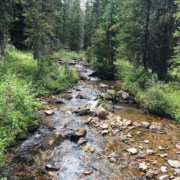Water Planning Committee Meeting Summary January 24, 2022 Webinar–Katherine Zitsch–north Georgia Water Supply Management
- Call to Order—Chair Jennifer Hoggatt-Missouri DNR called to order at 2:03 p.m. Central time.
- Introductions of Participants on the call: Jennifer Hoggatt, Chair; Sue Lowry; Katherine Zitsch; Drew Dehoff; Brian Atkins; Ed Swaim; Melinda Fegler; John Boyer; Amy Shallcross; Owen Mills; Mike Nardolilli; Kay Whittington; Jennifer Schellpeper.
- Webinar Presentation – Katherine Zitsch, Atlanta Regional Commission—Link to Katherine’s PowerPoint Slides
Katherine began her presentation reviewing the various water management entities in the greater Atlanta metro area: MNGWPD—Metro North Georgia Water Planning District—Atlanta in the middle. 10 other councils in GA. Other 10 don’t have implementation authority, but Metro does. Lake Lanier largest water supply. Another USACE facility, Lake Allatoona in Coosa Basin is 2nd in volume of supply. 80% of water supply comes from those 2 reservoirs. Two basins: some which flow to Atlantic and two river systems that flow to Gulf. Current water management was founded as wastewater to address CSO issues. 15 Counties—6 million people– 9th largest metro area (behind Philadelphia). 98% surface water supply. Droughts of 2007-2009 put Atlanta in the national news of nearing end of water supply. ACT—ends in Mobile Bay (does not include Florida). ACF—includes Florida. Water Conservation Programs—large decrease in per capita demand from 2000-2018. Gwinnett County Wastewater all pumped to top of basin for treatment and release back into Lake Lanier—most waste water releases used to flow to the east and out of basin, but by establishing the treatment plants higher in the watershed, the returns can be utilized. USACE Water Supply storage contract in Lake Lanier accounts for water put back in, get credit for 25%. Clayton County in southern metro has developed tertiary treatment wetlands, also at top end of their basin.
- Discuss Resiliency/Infrastructure opportunities passed in IIJA—USACE has just released their list of projects to fund with infrastructure dollars.
- ICWP Internship Program for Spring, 2022—Potential Study Projects. Will be selecting interns next week and still some flexibility in the three projects they will be completing.
- Report out of other ICWP committee activities—IWM topic of Trans-basin Transfers—DRBC will be first presenter and provides interesting examples of moving significant amounts of water out of basin. All ICWP committee members are invited to the February 9 webinar at 10 a.m. Central.
- Topics and speakers for future water planning learning opportunities
USGS has backed off of daily water use modeling and focusing on monthly values and estimates. Committee asked that Erik Smith from USGS Water Use program be invited to present at next meeting.
- Additional items to add to 2022 committee workplan
- Suggested topics– discussion of innovative funding approaches and North Dakota and Colorado were suggested as possible speakers
- Next call or webinar—set for March 7 if Erik Smith is available that day.
Water Planning Committee: Provide a forum of the exchange of ideas and concepts related to state and regional water planning.
2019/21 Accomplishments:
- Webinars from several state planning efforts
- Contributed Planning topics/speakers for Annual Meeting and Washington DC Roundtable
Issues for 2022 Workplan
- Continue with Webinar presentations from individual states on their water planning programs
- Support for PAS
- Water Quality and Infrastructure—how ICWP might integrate these topics with our main mission topic areas
- Planning topics at 2022 Washington Roundtable and Annual Fall Meeting
- Funding approaches used by various states:
- North Dakota
- Washington
- Colorado

